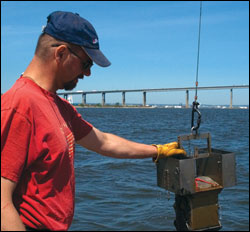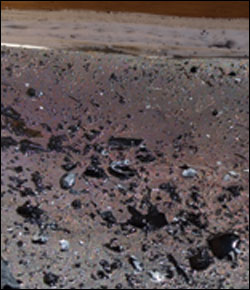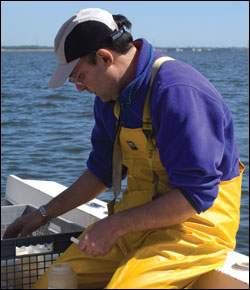By Erica Goldman
|
|
Grabbing mud from the bottom of the Patapsco, ecologist Roberto Llanso (bottom) and data coordinator Craig Bruce (top) find only a smattering of bottom life (center). Each year, the Chesapeake Bay Program takes stock of the state of the Bay's bottom-dwellers — inventorying the creatures that live in soft sediment communities. Photographs by Erica Goldman.



|
As the small survey boat passes under the imposing span of Baltimore's Key Bridge, Roberto Llanso rushes to get ready. Station 201, their first stop in the Patapsco River, is just a few minutes away and he hurries to pull on his yellow hip wader overalls, set up buckets, and label collection bags for the mud samples they will pull from the bottom
On this first day of the spring 2007 sampling season, Llanso and his data coordinator/ boat captain Craig Bruce still have some kinks to iron out. They encountered early morning mechanical difficulties and had to switch boats at the last minute so they're running late. They'll have to push to finish sampling all of the day's planned stations.
But Llanso has done the drill many times before and by the time they reach the station at the mouth of Baltimore Harbor, he's ready. Since 1999, Llanso has directed the Maryland portion of the Chesapeake Bay Program's Long-Term Benthic Monitoring Component. He's a benthic ecologist at Versar, the environmental consulting company that coordinates the survey for the Bay Program.
Since its inception in 1984, the Bay Program has been trying to inventory what lives in the soft bottom (the benthos) all over the Chesapeake. This long-term record provides scientists and managers with clues to the well-being of some of the Bay's bottom-dwellers — worms, some clams, insect larvae, and shrimp-like crustaceans. Because these creatures live entirely within the sediment they're called infauna, and in the Bay some 400 species have been identified.
Collectively, these bottom-dwellers tell a story about the state of the environment. Life on the bottom sends signals about the health of the water above it — polluted, healthy, or somewhere in-between, signs that constantly change as conditions in the Bay change. The presence, absence, or overall abundance of particular species can help managers understand the impacts of stressors such as shoreline development or nutrient loading. When species able to tolerate pollution proliferate, those organisms indicate that a particular site might have elevated concentrations of certain contaminants or low levels of dissolved oxygen. Other species that thrive only when conditions are ideal tell managers that the bottom, at least locally, is healthy.
But bottom-dwellers also change their environment. These organisms help circulate organic matter through the Bay's food web (trophic transfer). The water column affects the state of the life on the bottom and the life of the bottom affects the state of the water column. It's a classic chicken-and-egg conundrum and one that's difficult to tease apart out here on the Bay.
Sunlight glinting off the surface of the water makes it difficult for Bruce to focus, even with the shade from his sunglasses and baseball cap. He braces against the movement of the heavy metal grab as the winch jerks upward with the first sample in tow. "It's like driving someone else's quirky car," he says. Bruce too is a seasoned veteran at benthic sampling, but this is the first time he's worked the winch apparatus on this boat.
When the awkward metal grab breaches the surface, Bruce recognizes immediately that the mud sample is too small, falling well short of the 15-centimeter minimum needed to compute the benthic index of biotic integrity (B-IBI). He turns to Llanso and tells him that they'll have to take an additional sample at that station. The instrument again falls quickly to the Patapsco River's mucky bottom.
The benthic index scores the health of the soft sediment benthos on a scale from 1 to 5, with scores greater than 3 indicating good habitat quality. The index compares each site to a set of reference values expected under undegraded conditions in similar habitat types. These metrics include species abundance, biomass, and diversity, as well as the percentage of pollution-indicative and pollution-sensitive groups of animals.
The metal grab surfaces again. This time the mud sample measures large enough to count for the index calculation so Bruce dumps it onto a large mesh sieve. Jet-black sediment splashes Llanso's overalls and spatters his glasses, sending up a noxious whiff of rotten eggs. Llanso stores a small amount of mud in plastic sample bags for later analysis and washes the rest through the sieve, leaving behind only bigger particles. Aside from a few empty clamshells and a couple of polychaete worms, the sediment from this polluted part of the Patapsco harbors little life.
The mud from station 201 represents one of 27 sites in Maryland that are sampled each spring and summer to identify long-term trends in the condition of particular places over time. Later in the summer, the monitoring program also takes samples from a set of sites selected randomly each year. These so-called probability-based samples, 150 in Maryland and 100 in Virginia, help estimate the area of the estuary with benthic communities that meet or fail to meet the Bay Program's goal of a benthic index score of 3 or above for every site sampled.
So how is the Bay's benthos doing? Not well. Reports from 2006 indicate one of the worst years for benthic community condition on record. The Upper Bay and lower Eastern Shore measured fairly healthy, but the mainstem of the Bay, the Patapsco and Back rivers, the lower Western Shore, and the Potomac and Choptank rivers all received failing grades. Overall, 59 percent of the tidal Chesapeake Bay bottom failed to meet established restoration goals. And no signs suggest that 2007 will rate much better.
An unhealthy benthos means an unhealthy Bay, even if worms, clams, and insect larvae fly under most people's radars. Luckily, the reverse may also prove true. Improving the integrity of life on the bottom, by reducing the flow of nutrients and other pollutants into the water, might jumpstart a cascade of improvements — less algae, clearer water, more underwater grasses. "Save the Benthos" might not make a slogan catchy enough for bumper stickers, but it could prove critical to saving the Bay.
![[Maryland Sea Grant]](/GIFs/h_footer_mdsg.gif)